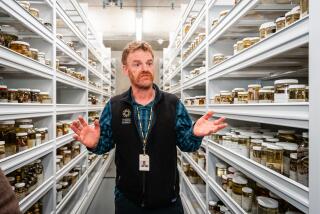‘Snake George’ Wages One-Man Campaign for Reptile Rights in Cyprus
- Share via
AYIOS NEOPHYTOS, Cyprus — Up in the hills behind the resort of Paphos, beside the ancient hermit’s monastery of St. Neophytos, is a small clearing. There, under the shade of a few trees, you will find Snake George, a middle-aged Austrian, surrounded by a rather large number of snakes.
The snakes are usually resting quietly in boxes, but Snake George will be only too delighted to pick one up, stroke it affectionately and pass it over to you.
It is all part of a one-man campaign by Hans Jorg Wiedl--better known in Cyprus as Snake George--who, as his nickname suggests, is a man with an unusual dream.
The dream is to persuade 678,000 mainly snake-hating Cypriots that the reptiles they share their island with should be protected rather than shot or hacked to death on sight.
George’s dream first took shape back in 1973, when he came to Cyprus with the Austrian contingent of the United Nations peacekeeping force.
Seeing a chameleon on the road one day, George picked it up. Three young boys came along, knocked the creature to the ground and jumped on it.
“They believed it was poisonous and they expected me to thank them for saving my life,” George said. “It was terrible to see them kill it.”
A similar incident occurred when George found a snake. Horrified by such brutal ignorance, he decided to try to show Cypriots how to live in peace with the slithery reptiles.
George has always had something of a passion for snakes. He volunteered for an extra 15 months of national service in Innsbruck because it enabled him to work and study in his spare time at the zoo there.
Later, he joined a merchant navy and traveled the world. When his ship docked at exotic ports and his mates headed for the local bars and massage parlors, George hopped on his bike and pedaled off to the nearest patch of desert or jungle to look for snakes.
Two experiences that have influenced his present campaign were a visit to the world famous Butanta snake park in Sao Paulo, Brazil, and the public relations acumen of a hotelier in Senegal who, on finding a large serpent in the swimming pool, rushed round to all his guests and told them to bring their cameras.
Now, married to a Cypriot and settled on the island, George hopes that his present exhibition will raise enough interest--and cash--to allow him to develop a permanent snake park.
The Abbot of St. Neophytos has offered him a site rent free for five years, and in May he founded the Cyprus Herpetological Society.
He knows his campaign will be an uphill struggle.
“For most Cypriots the only good snake is a dead one,” he said. “I am alone in trying to change their attitude. Most people think I’m crazy, though probably harmless.”
The fear and revulsion that most Cypriots feel toward snakes has a long history.
In the early fourth century, St. Helena of the Cross, mother of Constantine the Great, is said to have introduced cats into Cyprus with a twofold purpose. First, as one guide book notes, “as companions for the monks,” and, second, to kill the many snakes on the island.
Until recently the snakes have been holding their own. Now, with increasing development and destruction of their natural habitat, however, they are fast becoming endangered.
Since 1960 four species of harmless snakes have become extinct. Of the seven surviving species, three are venomous, although only one, the blunt nosed viper, is dangerous to humans. Of the other two, the cat snake is too small and the Montpellier is too shy and fast to be a problem.
Although he is the first to admit that his campaign is not an immediate runaway success, George says there are small signs of progress. The identification in 1985 of a new species of whip snake, endemic to Cyprus, raised considerable interest.
He has been invited to give slide lectures at a few hotels and schools, and villagers in the Paphos area are no longer surprised when George joins them at the local coffee shop with a snake around his arm.
“Why should they be killed?” George asks. “There are many drivers on this island who are more dangerous than all the vipers put together.”
More to Read
Sign up for Essential California
The most important California stories and recommendations in your inbox every morning.
You may occasionally receive promotional content from the Los Angeles Times.













